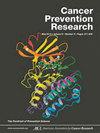求助PDF
{"title":"编辑对相关科学出版物的选择","authors":"","doi":"10.1158/1940-6207.capr-16-10-hfl","DOIUrl":null,"url":null,"abstract":"Highlights from the Literature| October 02 2023 Editors' Selections from Relevant Scientific Publications Author & Article Information Online ISSN: 1940-6215 Print ISSN: 1940-6207 ©2023 American Association for Cancer Research2023American Association for Cancer Research Cancer Prev Res (Phila) (2023) 16 (10): 539. https://doi.org/10.1158/1940-6207.CAPR-16-10-HFL Views Icon Views Article contents Figures & tables Video Audio Supplementary Data Peer Review Share Icon Share Facebook Twitter LinkedIn Email Tools Icon Tools Get Permissions Cite Icon Cite Search Site Article Versions Icon Versions Version of Record October 2 2023 Citation Editors' Selections from Relevant Scientific Publications. Cancer Prev Res (Phila) 1 October 2023; 16 (10): 539. https://doi.org/10.1158/1940-6207.CAPR-16-10-HFL Download citation file: Ris (Zotero) Reference Manager EasyBib Bookends Mendeley Papers EndNote RefWorks BibTex toolbar search Search Dropdown Menu toolbar search search input Search input auto suggest Search Advanced Search Breast cancer cells (by Annie Cavanagh via Flickr) Using phylogenetic of microdissected samples of cancer and non-cancer proliferative lesions, Nishimura et al. explored the genetic evolution of breast cancer, revealing a unique evolutionary pattern harboring der(1;16), a common driver alteration in 20% of all breast cancers and one-third of Luminal A breast cancers. In der(1;16)(+) cancers, the derivative chromosome was acquired from early puberty to late adolescence, followed by the emergence of a common ancestor by the patient's early 30s, leading to both cancerous and non-cancerous clones. These clones expanded significantly within the premenopausal breast before cancer diagnosis. Interestingly, multiple cancer clones originated from noncancer ancestors and there was no correlation between histology and the number of driver events, suggesting the involvement of epigenetic or microenvironmental factors in cancer development. These findings contribute to a better understanding of breast carcinogenesis and may improve early detection and prevention strategies. Nishimura... You do not currently have access to this content.","PeriodicalId":9373,"journal":{"name":"Cancer Prevention Research","volume":"42 1","pages":"0"},"PeriodicalIF":2.9000,"publicationDate":"2023-10-02","publicationTypes":"Journal Article","fieldsOfStudy":null,"isOpenAccess":false,"openAccessPdf":"","citationCount":"0","resultStr":"{\"title\":\"Editors' Selections from Relevant Scientific Publications\",\"authors\":\"\",\"doi\":\"10.1158/1940-6207.capr-16-10-hfl\",\"DOIUrl\":null,\"url\":null,\"abstract\":\"Highlights from the Literature| October 02 2023 Editors' Selections from Relevant Scientific Publications Author & Article Information Online ISSN: 1940-6215 Print ISSN: 1940-6207 ©2023 American Association for Cancer Research2023American Association for Cancer Research Cancer Prev Res (Phila) (2023) 16 (10): 539. https://doi.org/10.1158/1940-6207.CAPR-16-10-HFL Views Icon Views Article contents Figures & tables Video Audio Supplementary Data Peer Review Share Icon Share Facebook Twitter LinkedIn Email Tools Icon Tools Get Permissions Cite Icon Cite Search Site Article Versions Icon Versions Version of Record October 2 2023 Citation Editors' Selections from Relevant Scientific Publications. Cancer Prev Res (Phila) 1 October 2023; 16 (10): 539. https://doi.org/10.1158/1940-6207.CAPR-16-10-HFL Download citation file: Ris (Zotero) Reference Manager EasyBib Bookends Mendeley Papers EndNote RefWorks BibTex toolbar search Search Dropdown Menu toolbar search search input Search input auto suggest Search Advanced Search Breast cancer cells (by Annie Cavanagh via Flickr) Using phylogenetic of microdissected samples of cancer and non-cancer proliferative lesions, Nishimura et al. explored the genetic evolution of breast cancer, revealing a unique evolutionary pattern harboring der(1;16), a common driver alteration in 20% of all breast cancers and one-third of Luminal A breast cancers. In der(1;16)(+) cancers, the derivative chromosome was acquired from early puberty to late adolescence, followed by the emergence of a common ancestor by the patient's early 30s, leading to both cancerous and non-cancerous clones. These clones expanded significantly within the premenopausal breast before cancer diagnosis. Interestingly, multiple cancer clones originated from noncancer ancestors and there was no correlation between histology and the number of driver events, suggesting the involvement of epigenetic or microenvironmental factors in cancer development. These findings contribute to a better understanding of breast carcinogenesis and may improve early detection and prevention strategies. Nishimura... You do not currently have access to this content.\",\"PeriodicalId\":9373,\"journal\":{\"name\":\"Cancer Prevention Research\",\"volume\":\"42 1\",\"pages\":\"0\"},\"PeriodicalIF\":2.9000,\"publicationDate\":\"2023-10-02\",\"publicationTypes\":\"Journal Article\",\"fieldsOfStudy\":null,\"isOpenAccess\":false,\"openAccessPdf\":\"\",\"citationCount\":\"0\",\"resultStr\":null,\"platform\":\"Semanticscholar\",\"paperid\":null,\"PeriodicalName\":\"Cancer Prevention Research\",\"FirstCategoryId\":\"1085\",\"ListUrlMain\":\"https://doi.org/10.1158/1940-6207.capr-16-10-hfl\",\"RegionNum\":3,\"RegionCategory\":\"医学\",\"ArticlePicture\":[],\"TitleCN\":null,\"AbstractTextCN\":null,\"PMCID\":null,\"EPubDate\":\"\",\"PubModel\":\"\",\"JCR\":\"Q2\",\"JCRName\":\"ONCOLOGY\",\"Score\":null,\"Total\":0}","platform":"Semanticscholar","paperid":null,"PeriodicalName":"Cancer Prevention Research","FirstCategoryId":"1085","ListUrlMain":"https://doi.org/10.1158/1940-6207.capr-16-10-hfl","RegionNum":3,"RegionCategory":"医学","ArticlePicture":[],"TitleCN":null,"AbstractTextCN":null,"PMCID":null,"EPubDate":"","PubModel":"","JCR":"Q2","JCRName":"ONCOLOGY","Score":null,"Total":0}
引用次数: 0
引用
批量引用
Editors' Selections from Relevant Scientific Publications
Highlights from the Literature| October 02 2023 Editors' Selections from Relevant Scientific Publications Author & Article Information Online ISSN: 1940-6215 Print ISSN: 1940-6207 ©2023 American Association for Cancer Research2023American Association for Cancer Research Cancer Prev Res (Phila) (2023) 16 (10): 539. https://doi.org/10.1158/1940-6207.CAPR-16-10-HFL Views Icon Views Article contents Figures & tables Video Audio Supplementary Data Peer Review Share Icon Share Facebook Twitter LinkedIn Email Tools Icon Tools Get Permissions Cite Icon Cite Search Site Article Versions Icon Versions Version of Record October 2 2023 Citation Editors' Selections from Relevant Scientific Publications. Cancer Prev Res (Phila) 1 October 2023; 16 (10): 539. https://doi.org/10.1158/1940-6207.CAPR-16-10-HFL Download citation file: Ris (Zotero) Reference Manager EasyBib Bookends Mendeley Papers EndNote RefWorks BibTex toolbar search Search Dropdown Menu toolbar search search input Search input auto suggest Search Advanced Search Breast cancer cells (by Annie Cavanagh via Flickr) Using phylogenetic of microdissected samples of cancer and non-cancer proliferative lesions, Nishimura et al. explored the genetic evolution of breast cancer, revealing a unique evolutionary pattern harboring der(1;16), a common driver alteration in 20% of all breast cancers and one-third of Luminal A breast cancers. In der(1;16)(+) cancers, the derivative chromosome was acquired from early puberty to late adolescence, followed by the emergence of a common ancestor by the patient's early 30s, leading to both cancerous and non-cancerous clones. These clones expanded significantly within the premenopausal breast before cancer diagnosis. Interestingly, multiple cancer clones originated from noncancer ancestors and there was no correlation between histology and the number of driver events, suggesting the involvement of epigenetic or microenvironmental factors in cancer development. These findings contribute to a better understanding of breast carcinogenesis and may improve early detection and prevention strategies. Nishimura... You do not currently have access to this content.


